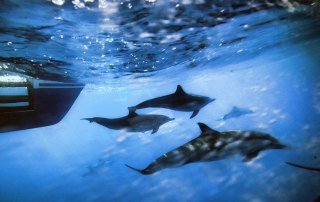by Associated Press
HONOLULU -- The Navy agreed to limit its use of sonar and other training that inadvertently harms whales, dolphins and other marine mammals off Hawaii and California in a settlement with environmental groups approved Monday.
A centerpiece of the agreement signed by a federal judge in Honolulu includes limits or bans on mid-frequency active sonar and explosives in specified areas around the Hawaiian Islands and Southern California, Earthjustice attorney David Henkin said. But some of the training will continue.
Sonar at a great distance can disrupt feeding and communication of marine mammals, and it can cause deafness or death at a closer distance, Henkin said. Four dolphins died in 2011 in San Diego when they got too close to an explosives training exercise, he said.

Lt. Cmdr. Matt Knight, a U.S. Pacific Fleet spokesman, said the settlement preserves key testing and training.
A centerpiece of the agreement signed by a federal judge in Honolulu includes limits or bans on mid-frequency active sonar and explosives in specified areas around the Hawaiian Islands and Southern California, Earthjustice attorney David Henkin said. But some of the training will continue.
Sonar at a great distance can disrupt feeding and communication of marine mammals, and it can cause deafness or death at a closer distance, Henkin said. Four dolphins died in 2011 in San Diego when they got too close to an explosives training exercise, he said.

This Oct. 15, 2014 photo shows dolphins swimming along the side of a boat off the coast of San Pedro, Calif. Richard Vogel / AP
The Navy's plans estimate it could inadvertently kill 155 whales and dolphins off Hawaii and Southern California, mostly from explosives. It estimated it could cause more than 11,000 serious injuries off the East Coast and 2,000 off Hawaii and Southern California. Lt. Cmdr. Matt Knight, a U.S. Pacific Fleet spokesman, said the settlement preserves key testing and training.
"Recognizing our environmental responsibilities, the Navy has been, and will continue to be, good environmental stewards as we prepare for and conduct missions in support of our national security," Knight said.
Under the agreement, the Navy cannot use sonar in Southern California habitat for beaked whales between Santa Catalina Island and San Nicolas Island. Sonar also is not allowed in blue whale feeding areas near San Diego, according to the environmental groups.
Related: 3 Million Whales Were Killed in the 20th Century: Report
In Hawaii, the deal prohibits sonar and explosives training on the eastern side of the Big Island and north of Molokai and Maui. The groups said that will protect Hawaiian monk seals and small populations of toothed whales, including the endangered false killer whale.
The Navy also won't be able to exceed a set number of major training exercises in the channel between Maui and the Big Island and on the western side of the Big Island.
Related: Whale Deaths Off Alaska Island Remain a Mystery: Scientist
"The goal of the settlement is to try to reduce as much as we can through an agreement with the Navy," Henkin said. "By establishing some safe havens ... the hope is to bring down those estimated numbers of injury and death."
Under the agreement, the Navy cannot use sonar in Southern California habitat for beaked whales between Santa Catalina Island and San Nicolas Island. Sonar also is not allowed in blue whale feeding areas near San Diego, according to the environmental groups.
Related: 3 Million Whales Were Killed in the 20th Century: Report
In Hawaii, the deal prohibits sonar and explosives training on the eastern side of the Big Island and north of Molokai and Maui. The groups said that will protect Hawaiian monk seals and small populations of toothed whales, including the endangered false killer whale.
The Navy also won't be able to exceed a set number of major training exercises in the channel between Maui and the Big Island and on the western side of the Big Island.
Related: Whale Deaths Off Alaska Island Remain a Mystery: Scientist
"The goal of the settlement is to try to reduce as much as we can through an agreement with the Navy," Henkin said. "By establishing some safe havens ... the hope is to bring down those estimated numbers of injury and death."
The agreement also says that if there are injuries or deaths, there will be a swift review by the National Marine Fisheries Service, which approved the Navy's plans, Henkin said.
The settlement comes after Earthjustice and other environmental groups sued in 2013, challenging the fisheries service's decision to allow the training. Additional environmental groups later filed a similar lawsuit in San Francisco. The two cases were consolidated in Hawaii, and the deal resolves both.
The settlement comes after Earthjustice and other environmental groups sued in 2013, challenging the fisheries service's decision to allow the training. Additional environmental groups later filed a similar lawsuit in San Francisco. The two cases were consolidated in Hawaii, and the deal resolves both.




Brak komentarzy:
Prześlij komentarz